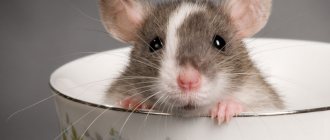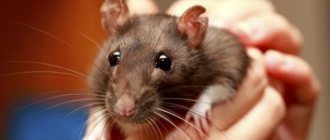Many owners are faced with unplanned rat offspring as rats become sexually mature at 5 weeks of age. This is why it is so important to separate all females from males when growing up. However, many owners breed rats.
In this article, we will look at how to properly breed rats and care for females. We will also learn about important factors affecting the health and future of rat droppings.
Making the decision to breed rats
Before mating two rats, it is important to know the genetic background of both parents and siblings. You also need to make sure they are in good health. Therefore, it is important to find a responsible and reliable veterinarian who will treat your animal if the need arises. Breeding pet store rats is not a good idea because you don't know the genetic history.
You should also have funds available to see a veterinarian if complications arise during the birth. For example, for an emergency caesarean section if the mother dies during childbirth or the babies get stuck in the birth canal. Money will also be needed for future medical complications, food and cages for 20 baby rats, and for your current rats.
If you take your rats to a pet store, be aware that they may sell your rats in exchange for snake food rather than pets. You can try advertising in online rat communities.
Are you thinking about breeding rats to make money? Then you should consider that the cost of care, housing, feeding and medical bills for your rats is more expensive than the money you will make from selling them.
A good breeder knows the pedigree and genetics of their rats and does not breed rats with health problems, mycoplasma disease, or a history of tumors in their pedigrees.
Is it possible to transport rats on an airplane?
Theoretically it is possible, but it is a troublesome task:
- Find out whether you can carry a rat according to the rules of this airport.
- Find out if your carrier transports rats.
- Get a veterinary certificate for the rodent 3 days in advance.
- Before checking in, go through vet control at the airport.
Do not forget about the laws of another country, whether the animal will be allowed there. It can only be carried in the cabin; it will not hold up in the luggage compartment. Don't put your rat through the scanner, it will hurt it. Don't open your rat's carrier on an airplane. It can only be fed through the grate.
Rats are reluctantly allowed on planesProblems are easier to solve if you can reach an agreement with the aircraft crew.
What you need to know before breeding
Anyone can be a breeder, but not everyone can be a good breeder!
When breeding for the greatest variety of patterns and colors of the babies, breed two rats of different colors and markings. For example, if you cross Dumbo with Dumbo, you will likely get all the children with Dumbo ears. Or if you cross Siamese with Siamese, you will most likely get all Siamese.
Breeding should be done with caution, as mating with sick rats or rats with a history of disease can have devastating consequences for parents and children.
Some health problems are not noticed until the rat reaches an advanced age. So just because a rat is young and looks healthy doesn't necessarily mean they don't have tumors or respiratory problems.
- Don't breed rats with pneumonia.
The disease can be transmitted to infants. This includes both men and women. It is most often transmitted by an infected rat sneezing near a healthy rat. If a rat is infected with pneumonia as an infant, symptoms usually do not appear until they are 3 months old. - Do not mate temperamental or high-biting rats.
These traits can be passed on to babies. Temperament is not always genetic. It can be caused by poor handling or care of the animal at an earlier age. But it is best to avoid breeding rats with temperament problems. - Do not breed females under 4 months old.
Their bodies are too small and birth can cause internal complications that can be life-threatening. They may also be too young to care for baby rats. - It is best not to breed females older than one year, especially females older than two years.
Caring for babies is stressful for a young and healthy mother, but for an older rat it can be very tiring for them and can ultimately shorten their lifespan or prevent the mother from caring for the babies.
Young mothers sometimes tend to have no maternal instincts and do not breastfeed or care for their babies. Sometimes they do not care for the babies for the first few hours or even days, but then they return and take on their motherly duties.
Breed only strong, well-nourished and healthy females of the breed.
Factors
The success of settlement depends on many factors, such as:
Character of animals.
The calmer and more balanced the animals, the easier the placement will be. At the same time, you should not rely on assessing the character of an animal only on the basis of its communication with you - often animals, peaceful and affectionate with people, are quite aggressive towards their own kind. Therefore, only those who already have several rats living in the same group can evaluate their character and understand what to prepare for.
Age of animals.
The younger the rats being housed, the easier the placement. The best age for adoption is from about 6-7 weeks to 2.5 months. Later than this age, rats usually begin hormonal changes that last 5-8 months, which significantly increases the struggle for leadership in the pack and complicates the process of moving in, and a younger rat pup is still too weak to meet unfamiliar rats that may behave aggressively. It is worth considering that you should not share old rats (more than 2 years old) with old rats - the stress and hassles that are inevitable during sharing can cause irreparable harm to their health. It is better to place a couple of baby rats with older rats (1.8-2 years) and aged rats - they will be busy playing with each other and will not bother the adults too much.
Like/Hate.
Sometimes a move-in that is ideal in all aspects leads to failure or incredible difficulties only because the rats being moved in did not like each other “at first sight.” It's hard to say why one rat might not like another, but the fact remains. You can often see the opposite situation: a rat breeder, preparing for a long process fraught with problems, is surprised to discover that the rats clearly sympathize with each other, became friends from the first meeting and even moved in together themselves. But you shouldn’t hope for such an outcome; it’s still rare.
Experience in rat breeding and housing.
The more rats the owner kept, the more additions he carried out, the easier it would be for him to carry out another one. No recommendation, no rule can replace actions based on intuition. It is always very important to see and understand in time that something has gone wrong, or to relax and not disturb the rats if everything is in order.
How to breed rats
Place the selected female and the selected male in the same cage. Watch them carefully to make sure they get along with each other and won't fight.
If they are friendly, observe and see if they mate. If you witness mating, simply wait 21-28 days for the babies to appear.
You can place a male and female in a cage together for a few weeks if they get along. Separate them in the last week of pregnancy unless you want more children. Or you can just combine them once for a few hours, it depends on what you want to do.
The female may become pregnant again immediately after giving birth, which can be a difficult ordeal for her. Therefore, if you do not want a second litter, separate the male and female in the last week of pregnancy.
If after 21-28 days there are no babies and you realize that the female is not pregnant after all, you can collect the selected pair and try again.
Why does the rat chew the cage?
By nature, a rat is supposed to chew everything in its path. The cell is no exception. Many pets do this at night, preventing them from falling asleep. Experience shows that for the animal this is more entertainment than an attempt to grind down its incisors. Rats chew the cage out of boredom if there is only one animal in it.
Most often, nervous animals engage in such things, but even completely healthy individuals will not deny themselves such pleasure. It is almost impossible to stop a rat from chewing its cage, but there are some things you can try:
- place a mineral stone, a twig, a piece of wood or a cracker in the cage before going to bed;
- cover your favorite “gnawing” spot with a mineral stone and hang branches between the bars;
- Move the cage to other objects with animals so that the animal does not get bored.
You should get several same-sex rats, then they will be busy with their relationships and, perhaps, will not touch the bars.
Inbreeding
Inbreeding is not a good idea. Mating relatives can cause genetic problems.
Some breeders do inbreeding, which they call line breeding, to produce a rat of a certain color. Usually in this case, rat relatives are mated.
Some studies show that inbreeding in wild rats leads to a shorter lifespan for the rats. Therefore, it is suspected that inbreeding in domestic rats will lead to the same result.
There is a lot of inbreeding going on in the rat business as they have huge cages where a huge number of rats live and breed without any concerns about relatives. Or they don't keep track of diseases or legacies.
Mass-bred rats tend to have a much shorter lifespan than rats bred by responsible breeders.
Why does a rat pee on your hands?
The pet doesn’t pee so much as mark its owner, and that’s normal. Like dogs, rodents must “stake out” their territory, including their owner and his belongings. Marking differs from peeing by the volume of urine produced: a drop is enough to indicate ownership.
Rats often mark their hands
The rat “pees” on people if they are saturated with strong odors: perfume or detergents. It is almost impossible to stop a rat from marking. A young male can be castrated, but this will not be a 100% guarantee either.
Source
What you need to know about rat pregnancy
Pregnancy in rats ranges from 21 to 23 days. Reproduction, fertilization and pregnancy always depend on the female cycle. Not everyone has the same cycle and it can vary by a couple of days.
Be careful when handling a pregnant female. Don't lift her by pressing on her belly, you may hurt her or the babies inside. During pregnancy, females are advised to limit climbing. They cannot jump as well as they used to and may fall, causing injury or complications.
You can let the mother play during pregnancy. But keep an eye on her so that she doesn't get injured or give birth in a place where you can't reach her.
You can also allow mom to play after giving birth, but make sure she doesn't leave the house for more than an hour for at least the first 2 weeks. Babies may become cold and hungry. If you allow mom to play after giving birth, make sure the crate door is closed. Otherwise, she may grab the babies one by one and take them to another place.
Caring for the rat and offspring
When the offspring are born, the new mother and babies will require special care. To make the female and her pups feel comfortable, the following recommendations should be followed:
- do not touch babies with your hands until they reach the age of 10-12 days;
- provide the female with a complete diet, feed her not only with industrial food, but also with natural food;
- do not place other rats in the cage;
- maintain cleanliness in the cage - in the first days after birth, you will have to remove the soiled litter and waste using a tablespoon.
Sometimes the rat refuses to feed the pups. In such a situation, you can look for a nurse for the brood, for example, among other breeders or in a pet store. You can also feed your babies yourself with baby formula using an insulin syringe.
After 2 weeks, the pups are ready to meet a person. If there are no objections from the mother, they can gradually be taught to be held. At the age of 5 weeks, males will have to be placed in a separate cage, otherwise they will begin to mate with their mother and sisters. Then new pregnancies cannot be avoided.
If a running wheel is installed in a cage with pups, it is necessary that the gap between the floor and the projectile is sufficient so that the animals can move freely there. Otherwise, children may get stuck under the wheel, which can lead to suffocation.
Housing for a pregnant female
It is recommended that the pregnant female be placed in her own cage a week before giving birth. Aquariums are the safest place for a rat to give birth. If you have a wire bottom or a cage with sides, babies may fall out or slip out of the cage, which can cause injury. Or death if they get stuck, cannot free themselves, or fall to the floor below where other animals can reach them.
Safe crates for babies are those with a flat bottom and 0.5 cm or less between slats.
Some pregnant females can live with other females without any problems. But some pregnant females are very defensive and may attack their other cage mates. It is best to place the nursing mother separately from others.
Some pregnant females begin building nests almost immediately after realizing they are pregnant. Others will wait until the last week to make a nest. Sometimes they build a nest when the young are born, or some don't build a nest at all.
It is best to provide pregnant mothers with a home, a needle, or a box to hide in. They are more comfortable if they have a darker place to rest.
Do not introduce new rats to pregnant females, they may react strongly and harm themselves and other rats.
If pregnant rats are kept together in the same cage, they are likely to mix up their litters. In rare cases, females may engage in a tug-of-war with the cubs, injuring them; if this occurs, separate the females.
Recommendations
A few general recommendations to make moving in easier:
Don't put cages next to each other. This is probably the main mistake of housekeepers: everyone tries to place the cage with newcomers closer to the cage with old-timers, so that the rats can “communicate” and get used to each other. In fact, this leads to the opposite effect: an increase and accumulation of aggression in rats who see a strange animal, a rival, but cannot reach it. Later, upon direct acquaintance, your old-timer will over and over again pour out all the accumulated aggression and irritation on the newcomer. This can lead to unpleasant consequences and make it impossible to move in before it has even begun. Therefore, place the cells as far apart as possible.
Take your time.
When moving in, you shouldn’t rush or force things; you should always give the rats time to get used to the situation and get used to the new member of the pack.
Go back.
If everything doesn’t go according to plan, then don’t be afraid to take a step back to the previous stage.
Keep calm.
Rats are excellent at recognizing your emotions, so try to calm down and not be nervous when introducing rats: your nervousness can be passed on to the animals. Therefore, before the process, it is better to get your nerves in order and stop trembling in your knees - this will help both you and the rats.
Don't be afraid to ask questions. In the appropriate topic on the forum, you can always ask for help or simply ask a question that interests you.
What you need to know about childbirth
Rats give birth to litters of 6-12 medium-sized pups. They can have up to 24 children. Rats have 12 nipples, so it can sometimes be difficult for mothers to feed their babies.
A pregnant mother will begin to bleed lightly before giving birth. The mother will lick each baby, chew the umbilical cord and eat the afterbirth.
Labor usually lasts 1-2 hours. If your rat labors for more than an hour without pushing out any babies, call your veterinarian immediately.
In rare cases, mothers may eat babies who die during childbirth. This is because in the wild, dead babies can attract predators; the female tries to protect the rest of the family from predators. In very rare cases, a mother may eat live babies if she is not feeding properly or if she thinks they are sick.
I have a rat peeing on my arms, what should I do? I seem to be nice to her but she does such nasty things
She's the one who loves you
Well, at first, when they first bought me, she also peed and pooped, but then she got used to my hands, and doesn’t even leave my side on the street, and gradually to other family members too.
Buy her diapers. The smallest size.
She's more likely to target you. On the part of the rat, this is a positive attitude, it seems to indicate that HER and only HER owners. Don't scold her for this. The rat will not mark a bad person that it does not like. As a rule, they often do this only the first time, then they get used to it and only do it suddenly. Rats can also pee out of fear if they are suddenly very frightened.
If it weren't for the tail, I would have gotten a rat too.
Rats mark all the time, but most often it is their owner. In this way, the animal shows that it loves you and considers you its own. It is useless to wean - it is their nature. Wild rats mark to maintain the collective scent of the pack. And when an animal returns after a long absence, the rest of the pack will certainly sweep it all over as a sign that they have recognized it and recognized it as theirs.
It’s not scary, sometimes crawling on my hands happens too))
Probably a small rat, not an adult. This will pass with age. When he pees on his hands, it is a sign of a good attitude towards you. He wants you to smell like him. That is, he considers you his own, family, one might say. I have two adult rats, and we placed a small one with them. At first they pissed him all over, it was even a pity, he walked around wet for two days. Now they're like family!
Let her go to relieve herself, and then pick her up!
Source
What you need to know about baby rats
Rats are very vocal and, as a rule, squeak a lot. The mother rat will carry her babies with her teeth (in her mouth), this will not harm them. In the first week, babies are mostly dependent on their mother, but will try to crawl.
Rats are born hairless and pink. On day 3, you may begin to see hints of baby markings and some fur growth. They are born with their eyes and ears closed. The ears of rats are folded towards the head and appear almost completely attached to the head at birth and gradually open and widen. Their ears will open fully at about 9 days.
It will take about 10-14 days for the rat to become covered in light fur. Rats take 10-14 days to open their eyes. Babies will become very active when they open their eyes and begin to explore.
Babies begin chewing food at about 2 weeks of age. Usually immediately after opening the eyes.
Infants should not be separated from their mother before 3 weeks. 4 weeks is the recommended weaning age. Females can stay with mom and males with dad after weaning.
Do rats like to be petted?
Tame animals gladly accept affection from their owners, especially if they do not try to lift them by the tail. You should pick up the rat with both hands: it often climbs onto your outstretched palm. In order for a rat to like it, you need to stroke its head, scratch it behind its ears and on its cheeks. The animal enjoys a gentle touch on the withers and stroking the back in the direction “from the head”. Some animals trust their owner to scratch their belly, but not all. You can observe the social interactions of rodents to understand what they like.
Rats love affection
Treatment
The damaged area must be constantly treated with local antiseptics, for example, Chlorhexidine, as well as antibacterial drugs.
If the suppuration is severe, antibacterial medications are prescribed by injection.
You can apply bandages with Levomekol or Vishnevsky ointments to the wound, and Xidikol is used to stop bleeding and dry it out.
If you have severe pain, you cannot do without painkillers. Dead tissue fragments are removed surgically.
In advanced cases, unfortunately, it is often necessary to amputate a limb.
The owner is advised to review the conditions under which the pet is kept, replace the floor with a dry and smooth one, and lay down soft bedding.
It is also important to disinfect the cage, include vitamin C in the diet and exclude fatty foods.
Call a veterinarian ratologist to your home around the clock
Specialists at the VetDrug clinic recommend that you do not delay contacting a professional if you notice the first signs of “painful heels.”
Our staff arrives 24 hours a day and provides qualified assistance to your pets.
It is convenient to call a professional because:
- pet owners have the right to choose any day for a veterinarian visit,
- the pet remains in a home environment where he will be comfortable,
- no need to wait in line for an appointment,
- For clients calling a veterinarian, the same prices apply as for clinic visitors.
Departure is carried out in Moscow and the Moscow region. Applications are accepted 24 hours a day by calling 8 (495) 796-16-02.
Symptoms
There are four stages of development of the disease:
- Superficial skin lesions. Often goes away on its own, the prognosis is favorable.
- Infection of superficial layers. Pathogenic bacteria multiply on the sole, but they haven’t gotten inside yet. Timely treatment can quickly get rid of pododermatitis.
- Penetration. Bacteria enter the deep layers, so immediate doctor intervention is required, including surgery. Even with complete healing, relapses are possible. The forecast is cautious.
- Deep penetration. The skin, subcutaneous tissue and tendon apparatus are damaged. The treatment method is surgical with a poor prognosis.
In the initial phase of the disease, compactions in the form of calluses become noticeable. Then appear:
- hematomas and fissures,
- peeling,
- sores,
- When pathogenic microflora enters, suppuration begins, parasites can settle in, and fungal infections can occur.
The animal loses its appetite, stops actively moving and lies down more, and may even “cry.” If you don’t start fighting for your pet’s life, it may die from septic damage and exhaustion of the body.
Can pet rats hiccup?
Hiccups in an animal occur against the background of:
- overeating;
- nervous excitement;
- hypothermia;
- helminthic infestation.
If the case of hiccups is isolated, then there is no need to worry - perhaps the rat has simply eaten too much. If attacks of hiccups occur periodically, then you need to think about changing food and carrying out preventive deworming.
Important! When hiccups are accompanied by heavy, wheezing breathing, take your pet to the vet immediately. There is a high risk of pneumonia or pneumonia. Without proper treatment, this can lead to the death of your pet.
Teeth grinding
Rodent lovers also hear another specific sound, which experts call “bruxism.” Many people suffer from bruxism (“teeth grinding”) during sleep. With rats the situation is a little different; you can hear them grinding their teeth, as if they were grinding something very hard. A sort of creaking or grinding sound. Everything is natural - the usual behavior of all rodents. Some rats "gnash" quite intelligently; These sounds can only be clearly distinguished when in close proximity to the cell. By the way, bruxism is a good sign for rats: it means that she is now relaxed, and everything is fine in her life!
Grinding your teeth is actually very important for rats. Her front incisors are constantly growing and need to be ground down. Take a closer look at your little pet to see if the incisors are causing him any discomfort. Is everything okay with eating? If you see something suspicious, consult your veterinarian. In particularly advanced cases, surgery is sometimes indicated.
Original publication: How Rats Communicate, And How To Interpret It. Source and photo:
What sound does a wounded animal make?
May scream, chirp, or remain silent due to painful shock. Most often, domestic rats suffer injuries to their paws: a torn claw, a cut, a splinter, a broken toe or tail, or a pinched tail.
If you find that your pet has injured itself, calm down, don’t panic, give it first aid. Treat the wound with an anti-inflammatory agent. Try to stop the bleeding with hydrogen peroxide.
What sounds do domestic and wild rats make?
Under natural conditions, rodents live in colonies and communicate in three complementary ways:
- High frequency sounds. Used by cubs to find their mother or by males during the mating season. The human ear is not able to recognize this signal.
- Chirping. Rapid rhythmic chattering of teeth is used to warn relatives of approaching danger. A domestic rat can also chirp if it is scared.
- Smells. They play a key role, since the rat’s sense of smell is more developed than other senses. Wild animals mark their territory with scent glands, and also recognize relatives by a specific smell.
Reference! Rats are myopic, so visual perception does not play a key role for them.
As they became domesticated, people learned to distinguish and identify some of the sounds of their pets.
With the help of a piercing loud squeak, the animal tries to convey its fear or pain. Inspect the area around the cage and analyze what might have frightened your pet. It is likely that the rat could hear the cat or the hum of the vacuum cleaner from the next room.
If the rat does not live alone in the cage, put it away. Inspect carefully for bites and injuries. If there are no visible signs of damage on the body, and the pet does not calm down and continues to squeak for a long time, contact your veterinarian immediately. Your pet may experience severe pain due to internal injuries.
A quiet, barely audible squeak from stroking means that the rodent enjoys communicating with the owner.
An abrupt loud squeak when pulled out of the cage signals that the pet is not in the mood to contact a person.











